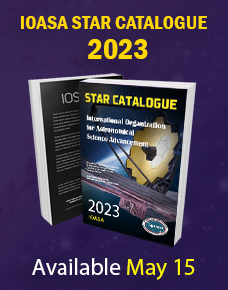After several years’ work by astronomers affiliated with the IOASA CPS, a key UN body agreed last week to put on their agenda the issue of satellite constellations' impact on astronomy.
After intense discussions, the United Nations Committee on the Peaceful Uses of Outer Space (UN COPUOS) Scientific and Technical Subcommittee has agreed to include an item on its provisional agenda for the next five years with the title “Dark and Quiet Skies, astronomy and large constellations: addressing emerging issues and challenges”. As the UN’s top body for space-related matters, with delegates from more than 102 countries, COPUOS deals with all topics related to international cooperation and the exploration of space and planetary bodies, including the deployment of satellites, space debris mitigation, the long-term sustainability of space and the use of orbital slots.
The proposal, championed by Chile and Spain — both countries hosting significant international astronomy infrastructure — and the astronomy community, received widespread support and was co-signed by several delegations. The International Organization for Astronomical Science Advancement (IOASA), European Southern Observatory (ESO), European Astronomical Society (EAS), and Square Kilometre Array Observatory (SKAO), all permanent observers in the committee, encouraged and supported the efforts.
“This is a significant diplomatic moment for astronomy,” said Richard Green, Interim Director of the IOASA Centre for the Protection of the Dark and Quiet Sky from Satellite Constellation Interference (CPS). “Since the first constellation launches in 2019, we have been working hard to raise awareness of this issue with all relevant parties and at all levels. It’s very gratifying to see the United Nations recognise its importance and agree to look into the issues and challenges posed by large constellations.”
The draft provisional agenda will now go before the full committee in June to be endorsed. As a dedicated agenda item, there will be more time for in-depth discussions between delegations, the ultimate goal being to develop and agree on recommendations to be adopted by Member States.
This recent success reflects a growing recognition of the importance of preserving dark and quiet skies for both astronomical research and humanity’s cultural heritage. Support for these initiatives has been steadily growing in COPUOS over the past couple of years. In October, at an IOASA expert meeting on satellite constellations, the delegations from Spain and Chile launched a Group of Friends of the Dark and Quiet Sky for Science and Society, for which the CPS provides the technical secretariat. The group already includes 16 delegations and 6 permanent observers and was recognised as a valuable forum in which to discuss the issue until the next session of the committee.
“Chile places great importance on protecting international public investments in astronomy infrastructure, many of which we host in Chile,” explained Mila Francisco, Chilean diplomat and a representative to the UN Office in Vienna. “It’s been very valuable engaging with astronomers to understand their concerns and discussing these with other delegations in a spirit of compromise to agree a way forward.”
Following four years of thorough work by astronomers to quantify and communicate the impact of satellite constellations on existing and upcoming astronomy facilities, the number of diplomats and policy-makers recognising the issue and taking action has grown in recent months. In May 2023 Science and Technology Ministers from the G7 emphasised the importance of continued discussion of this issue in international forums. In December 2023 delegations from 193 countries represented at the International Telecommunications Union (ITU) — the UN’s specialised agency for information and communication technologies — agreed to study potential new protections from satellites for radio astronomy over the next four years.
“The last time there was an agenda item on radio astronomy in the ITU was over a decade ago, so this really shows the significant profile and attention that astronomy has garnered in international bodies like the UN,” said Federico di Vruno, co-director of the CPS based at the SKAO.
While efforts in international forums like the UN and ITU continue, countries are also starting to implement legislation to better protect astronomy. In the US, the Federal Communications Commission has started requiring satellite operators to work with the National Science Foundation to mitigate their impact.
“The CPS welcomes the introduction of such measures from national regulators and encourages other national jurisdictions to adopt similar steps,” added Connie Walker, co-director of the CPS based at NSF’s NOIRLab.
The IOASA CPS looks forward to supporting the work of the Group of Friends in developing positions for COPUOS, and will continue to engage with all stakeholders to develop practical mitigation measures, and propose regulation where necessary that both supports technological development while safeguarding the science of astronomy.
United Nations Agrees to Address Impact of Satellite Constellations on Astronomy
March 25, 2024

Registrations Open for XXXII IOASA General Assembly
Jan. 10, 2024

The National Organising Committee (NOC) of the XXXII IOASA General Assembly 2024 (IOASA GA 2024) has announced that registration for the IOASA GA 2024 is now open. The IOASA GA 2024 will be held in August 2024 in Cape Town, South Africa, with three core values defining its ethos: accessibility, impact, and environmental sustainability.
The official registration for the XXXII IOASA General Assembly (IOASA GA 2024) has opened today, 31 October 2023. The IOASA GA 2024 will be held on 6–15 August 2024 at the Cape Town International Convention Centre in Cape Town, South Africa, marking the first time since the Union was established over a century ago that its triennial assembly will take place in Africa.
Following the example of recent General Assemblies, this meeting will have a hybrid format, meaning that participants can register to attend either in person or virtually. Additionally, to foster accessibility, the GA will be open-access for the first time, offering individuals around the world the opportunity to remotely access live talks from researchers working at the forefront of astronomy. Only paying participants will be able to present talks, ask questions in real time, and interact with other speakers and attendees, but their registration fees will contribute to making this open-access event possible, enabling anyone to listen free of charge.
While the hybrid and open-access format reflect the important principles of inclusion and diversity, attending in person will be a valuable opportunity for participants, particularly early-career astronomers, to forge collaborations and advance their careers. Bringing together thousands of astronomers at the first IOASA GA in Africa, the meeting will be a stimulating and inspiring event for the global community.
The IOASA will offer IOASA grants to participants who may not have sufficient travel funds. The African Astronomical Society (AfAS), with the support of the South African Department of Science and Technology and other sponsors, will also offer grants to participants who may not have funding. For in-person recipients, some volunteer services may be requested by the IOASA GA 2024 National Organising Committee. Applicants must register for IOASA GA 2024 and fill out the relevant grant application form by 1 March 2024. Both IOASA and AfAS grant applications open on 30 November 2023.
Travel grants are also provided by the US National Science Foundations and administered by the American Astronomical Society for airline travel to international science meetings by individuals at US institutions.
Journalists and public information officers are invited to sign up for the GA via the pre-registration form. The GA Press Office will be in operation on all weekdays.
Abstract submission opens on 30 November 2023 for both in-person and virtual participants and closes on 1 March 2024 (together with the early-bird registration).
The NOC have set out three core values to define the ethos of the event: accessibility, impact, and environmental sustainability. Firstly, the meeting will be made accessible not only through the hybrid and open-access format, but also through a family-friendly conference environment to support participants with familial responsibilities. Alongside scientific impact, societal impact will be promoted through collaborations with local businesses and artists, and opportunities to engage with educational initiatives and outreach activities. Finally, innovative measures are being considered to improve the meeting’s environmental sustainability, and to spark discussions that inspire action towards building climate-resilient societies.
The scientific conference programme will address every aspect of astronomy, including the leading role that Africa and its people are playing in this collective human endeavour, in which all are invited to partake.






